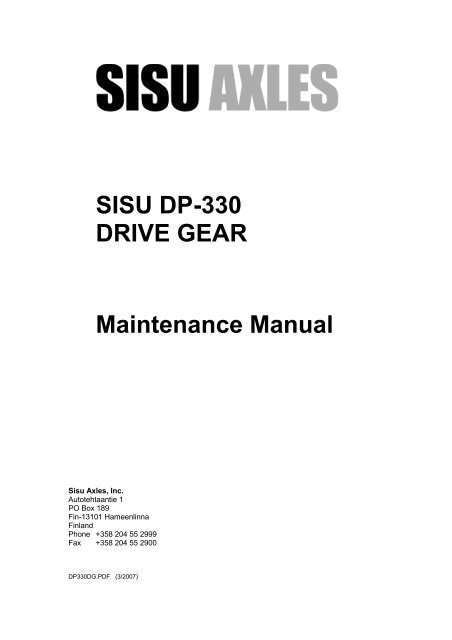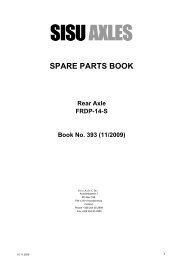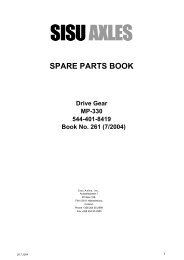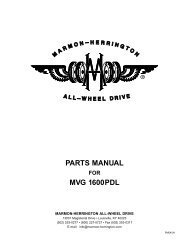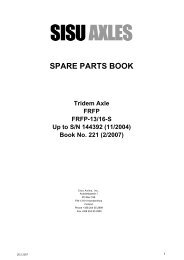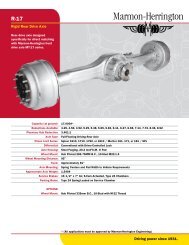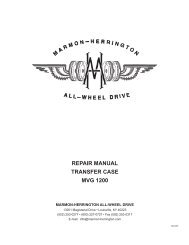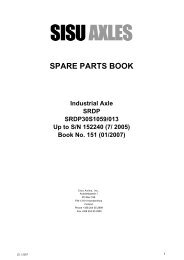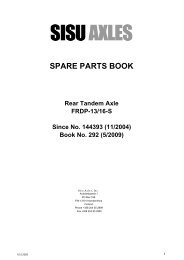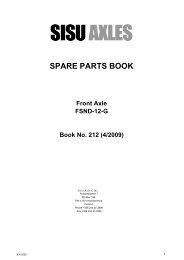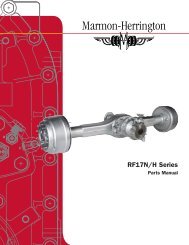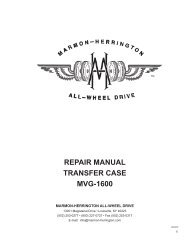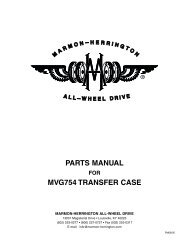SISU DP-330 DRIVE GEAR Maintenance Manual - Marmon ...
SISU DP-330 DRIVE GEAR Maintenance Manual - Marmon ...
SISU DP-330 DRIVE GEAR Maintenance Manual - Marmon ...
You also want an ePaper? Increase the reach of your titles
YUMPU automatically turns print PDFs into web optimized ePapers that Google loves.
<strong>SISU</strong> <strong>DP</strong>-<strong>330</strong><br />
<strong>DRIVE</strong> <strong>GEAR</strong><br />
<strong>Maintenance</strong> <strong>Manual</strong><br />
Sisu Axles, Inc.<br />
Autotehtaantie 1<br />
PO Box 189<br />
Fin-13101 Hameenlinna<br />
Finland<br />
Phone +358 204 55 2999<br />
Fax +358 204 55 2900<br />
<strong>DP</strong><strong>330</strong>DG.PDF (3/2007)
<strong>Maintenance</strong> <strong>Manual</strong><br />
<strong>SISU</strong> <strong>DP</strong>-<strong>330</strong> Drive Gear<br />
------------------------------------------------------------------------------------------------------------------------------------------------<br />
TABLE OF CONTENTS<br />
REPAIR INSTRUCTIONS FOR<br />
<strong>SISU</strong> FX<strong>DP</strong> <strong>DRIVE</strong> <strong>GEAR</strong><br />
---------------------------------------------------------------------------------------------------------------------------<br />
1<br />
Page<br />
CARRIER UNIT.......................................................................................................................... 2<br />
Removing the carrier unit from the axle body....................................................................... 2<br />
DIFFERENTIAL LOCK...............................................................................................................3<br />
Disassembly ........................................................................................................................ 3<br />
Assembly............................................................................................................................. 4<br />
Lock Adjustment .................................................................................................................. 4<br />
DIFFERENTIAL.......................................................................................................................... 4<br />
Disassembly ........................................................................................................................ 4<br />
Assembly............................................................................................................................. 6<br />
PINION UNIT ............................................................................................................................. 6<br />
Disassembly ........................................................................................................................ 6<br />
Assembly............................................................................................................................. 6<br />
Pinion unit installation .......................................................................................................... 7<br />
CARRIER ASSEMBLY............................................................................................................... 7<br />
Installation of the differential assembly ................................................................................ 7<br />
Assembly and adjustment of gear backlash and contact ..................................................... 8<br />
Replacement of the ring and pinion gears ........................................................................... 8<br />
Installation of the carrier assembly .................................................................................... 10<br />
OIL CHECKS AND OIL CHANGES.......................................................................................... 10<br />
Differential oils ................................................................................................................... 10<br />
SPECIAL TOOLS..................................................................................................................... 11<br />
TORQUE VALUES................................................................................................................... 11<br />
LUBRICATION......................................................................................................................... 11<br />
Oil volumes........................................................................................................................ 11<br />
TECHNICAL DATA .................................................................................................................. 12<br />
NOTE !<br />
This <strong>Manual</strong> is intended for use by experienced mechanics using safe procedures in properly equipped<br />
shops. Safety precautions should always be followed such as wearing safety glasses, using adequate<br />
lifting aids, and using tools and equipment in good condition. Sisu Axles, Inc., its agents, associates or<br />
representatives are not responsible for damage or injury occurring while working on their components.<br />
<strong>SISU</strong> AXLES, INC.<br />
P. O. Box<br />
FIN 13101 Hämeenlinna Finland<br />
Phone Int. + 358 204 55 2999 Fax Int. + 358 204 55 2900
<strong>Maintenance</strong> <strong>Manual</strong><br />
<strong>SISU</strong> <strong>DP</strong>-<strong>330</strong> Drive Gear<br />
------------------------------------------------------------------------------------------------------------------------------------------------<br />
CARRIER UNIT<br />
Removing the carrier unit from the axle body<br />
Drain carrier oil.<br />
Remove the cotter pin from the propeller shaft flange nut and unscrew the nut a few turns. Use a pry bar to keep<br />
the flange stationary while unscrewing the nut. It is best to do this while the axle is in the vehicle or in a repairs<br />
stand if one is available.<br />
Remove the axle from the vehicle. (The carrier can be removed alone while the axle remains in the vehicle by<br />
using a special lift). Place the axle assembly on a repair stand so the pinion flange is facing upward.<br />
Removing the carrier from the axle housing:<br />
Remove the carrier housing cap screws and screw two of them into the threaded holes in the carrier housing to act<br />
as extractors. (These holes are protected by plastic plugs). Remove the carrier with suitable lifting gear and place<br />
it on a repair stand with the ring gear up..<br />
Picture 1. Carrier mounted on repair stand.<br />
---------------------------------------------------------------------------------------------------------------------------<br />
2
<strong>Maintenance</strong> <strong>Manual</strong><br />
<strong>SISU</strong> <strong>DP</strong>-<strong>330</strong> Drive Gear<br />
------------------------------------------------------------------------------------------------------------------------------------------------<br />
DIFFERENTIAL LOCK<br />
Disassembly<br />
Remove the lock cylinder cover retaining screws (5<br />
pcs). Remove the cover and the diaphragm.<br />
Picture 2. . Lock cylinder cover removed and<br />
diaphragm is loose.<br />
Remove the diaphragm support cup cap screw and<br />
the cup and spring.<br />
Picture 3. Support cup and spring ready for removal.<br />
Loosen the fork lock screw approx. 2 turns (for<br />
access, remove the plug from the casing) and<br />
remove the fork shaft by turning it counter-clockwise<br />
with a suitable open end wrench.<br />
Picture 4. Allen wrench in fork lock screw access<br />
hole.<br />
Loosen the sliding ring lock screw and remove the<br />
snap ring. Remove the fork, sliding ring and shoes.<br />
Picture 5. Fork shaft removal.<br />
Picture 6. Sliding ring lock screw loosened (arrow).<br />
Picture 7. Removing sliding ring snap ring.<br />
---------------------------------------------------------------------------------------------------------------------------<br />
3
<strong>Maintenance</strong> <strong>Manual</strong><br />
<strong>SISU</strong> <strong>DP</strong>-<strong>330</strong> Drive Gear<br />
------------------------------------------------------------------------------------------------------------------------------------------------<br />
Assembly<br />
Inspect all lock components to ensure that they are in<br />
good condition and not excessively worn. Replace all<br />
damaged parts. Assemble by follow-ing the above<br />
steps in reverse order.<br />
Lock Adjustment<br />
For adjustment, the following parts must be removed.<br />
1. Cover<br />
2. Diaphragm<br />
3. Screw<br />
4. Cup<br />
5. Spring<br />
Lock Adjustment:<br />
1. Engage the dog clutch of the differential lock by<br />
pushing the fork shaft in all the way.<br />
2. Place the cup (4) on the fork shaft without the<br />
retaining screw.<br />
3. Adjust the fork shaft by turning it in the fork so<br />
that the cup touches both the end of the shaft and<br />
the bottom of the casing simultaneously.<br />
4. Check by rotating the pinion or input shaft and<br />
pushing the fork shaft at the same time to see if<br />
the shaft will go in further.<br />
5. If the shaft and the fork went in further, repeat<br />
step 3.<br />
6. When the shaft does not go in further, turn it<br />
clockwise 1/4 turn<br />
7. Tighten the fork locking screw (6).<br />
8. Install the cup (4) and retaining screw(3).Push on<br />
support cup manually to make sure that the cup<br />
rim touches the bottom of the casing<br />
9. Install the cup cap screw and tighten to 30 Nm[22<br />
lb-ft]. Use sealant on the hole plug threads.<br />
Picture 8. Differential lock cylinder.<br />
DIFFERENTIAL<br />
Disassembly<br />
If the ring and pinion are in good condition and will be<br />
reused, check and note the gear backlash before<br />
disassembly.<br />
NOTE: If the bearings are damaged, this<br />
measurement cannot be used at reassembly.<br />
NOTE: Remove the differential lock before removing<br />
the ring gear and differential assembly.<br />
Mark carrier bearing caps and the adjacent case with<br />
a center punch to identify their positions. Remove<br />
bearing cap cap screws, bearing caps, and the<br />
bearing cups.<br />
Remove complete ring gear and differential assembly<br />
and place in a vise or repair fixture.<br />
Picture 9. Area to be marked with center punch.<br />
Center punch adjacent surfaces on case halves.<br />
Remove the differential case nuts and the upper case<br />
half. If the ring and pinion are to be replaced, remove<br />
the lower case half and differential gears.<br />
Remove the differential lock engagement gear (45)<br />
and its guide ring (33) from the differential case. (<br />
picture 10)<br />
---------------------------------------------------------------------------------------------------------------------------<br />
4
<strong>Maintenance</strong> <strong>Manual</strong><br />
<strong>SISU</strong> <strong>DP</strong>-<strong>330</strong> Drive Gear<br />
------------------------------------------------------------------------------------------------------------------------------------------------<br />
58<br />
57<br />
21<br />
53<br />
54<br />
55<br />
56<br />
22<br />
23<br />
1<br />
52<br />
34<br />
2<br />
3 4<br />
43<br />
44<br />
Picture 10. Exploded view of carrier assembly.<br />
41<br />
41<br />
5<br />
26<br />
6<br />
7<br />
---------------------------------------------------------------------------------------------------------------------------<br />
5<br />
8<br />
18 19 20 44<br />
42<br />
33<br />
32<br />
29<br />
9<br />
10 11<br />
48<br />
50<br />
51<br />
28 27<br />
35<br />
12 13<br />
46<br />
47<br />
49<br />
26<br />
30<br />
31<br />
14<br />
45<br />
24<br />
25<br />
36<br />
15<br />
22<br />
23<br />
37<br />
16<br />
21<br />
38 40<br />
17<br />
39 44
<strong>Maintenance</strong> <strong>Manual</strong><br />
<strong>SISU</strong> <strong>DP</strong>-<strong>330</strong> Drive Gear<br />
------------------------------------------------------------------------------------------------------------------------------------------------<br />
Assembly<br />
(See picture 10)<br />
Inspect all parts carefully to ensure that all parts to be<br />
reused are in good condition. Press the bearing<br />
cones into the case halves if they are to be replaced.<br />
Install the ring gear side of the case half on the ring<br />
gear. Place the differential side gear (32) with the<br />
guide ring (33) in the case half. Install the differential<br />
lock engagement gear. Place the spider gears and<br />
thrust washers on the spider and then on the side<br />
gear in the case half.<br />
Place the other side gear and its thrust washer on top<br />
of the spider gears.<br />
Install the upper case half with punch marks lined up<br />
and insert cap screws and washers. Tighten nuts to<br />
320 Nm [236 lb-ft] torque. Always use new nuts.<br />
Picture 11. Exploded view of differential (with<br />
differential lock)<br />
PINION UNIT<br />
Disassembly<br />
Remove cap screws holding the pinion housing to the<br />
differential housing and, with the extractor screws<br />
(M12) screwed in the threaded holes, separate the<br />
two housings.<br />
Lift the pinion unit off the differential housing. Save<br />
shim (Item 17 in picture 10) for use at reassembly.<br />
Remove the pinion flange nut. Hold the flange with a<br />
suitable bar to prevent its turning.<br />
Push the pinion out of the housing with a shop press.<br />
The bearing cone (16), spacer (10), and shims (11),<br />
will come out with the pinion. The complete outer<br />
bearing (8 & 9), seal (7), and cup of the inner bearing<br />
(16) will stay in the housing. Put the shims aside to<br />
use at reassembly if the gears are to be reused.<br />
Remove the seal, the outer bearing and the bearing<br />
cups if required, from the housing.<br />
Assembly<br />
Inspect all parts carefully to ensure that all that are to<br />
be reused are in good condition. Only bearings in<br />
perfect condition may be reused. If ring and pinion<br />
are to be replaced, new bearings must be used as<br />
well.<br />
Press the bearing cone onto the pinion. Install the<br />
spacer bushing and the old shim(s) on top of the<br />
bearing on the pinion. Press the outer bearing cup<br />
into the housing<br />
Lift the housing onto the pinion and place the outer<br />
bearing cone on the pinion. Use a suitable sleeve to<br />
press the outer bearing cone into place while rotating<br />
the housing by hand. Increase the force to 160 kN<br />
(35,000 lbs.). If the bearing binds, press pinion out<br />
and replace the shim(s) and/or the spacer with others<br />
to increase clearance and repeat the process.<br />
---------------------------------------------------------------------------------------------------------------------------<br />
6
<strong>Maintenance</strong> <strong>Manual</strong><br />
<strong>SISU</strong> <strong>DP</strong>-<strong>330</strong> Drive Gear<br />
------------------------------------------------------------------------------------------------------------------------------------------------<br />
With bearings fully seated and without the seal in<br />
place, check the pinion rotation force while maintaining<br />
160 kN (35,000 lbs.) pressure as follows:<br />
Wrap a few turns of string around the pinion housing<br />
just below the flange and pull the string with a spring<br />
scale. The correct value is 55 - 80 N [12.5 - 18 lb].<br />
Replace shims if required until correct rotating torque<br />
value is reached.<br />
Picture 12. Checking the pinion bearing rolling<br />
torque with a spring scale.<br />
Following spacer bushings and shims are available:<br />
Description Part No. Thickness<br />
mm inch<br />
Spacer 099 557 1026 53.7 2.114<br />
Spacer 099 557 1027 53.72 2.115<br />
Spacer 099 557 1028 53.74 2.116<br />
Spacer 099 557 1029 53.76 2.1165<br />
Spacer 099 557 1030 53.78 2.117<br />
Shim 099 517 1000 0.30 0.012<br />
Shim 099 517 1001 0.40 0.016<br />
Shim 099 517 1002 0.50 0.020<br />
Fill the bearing cavity with grease and install the seal.<br />
Install the pinion companion flange with its seal<br />
protection ring and V-Seal. Screw the pinion nut<br />
hand tight.<br />
If a shop press is not available for assembly,<br />
adjustment can be performed as follows:<br />
Assemble as described but instead of pressing, install<br />
the companion flange, washer and nut and tighten the<br />
nut to 1,300 Nm [970 lb-ft] torque. Measure and<br />
adjust the bearing rotating torque as previously<br />
described. When the rotating force is correct, install<br />
the companion flange, washer and nut and tighten the<br />
nut to 1,300 Nm [970 lb-ft] torque and secure it with a<br />
cotter pin<br />
Pinion unit installation<br />
Place previously used adjustment shim(s) (17 in<br />
picture 10) on carrier housing and place the pinion<br />
housing on the carrier. Coat mating surfaces with<br />
Silmate Silicone Rubber RTV 1473 or similar Room<br />
Temperature Vulcanizing sealant. Install cap screws<br />
and tighten to 150 Nm [110 lb-ft] torque.<br />
CARRIER ASSEMBLY<br />
Installation of the differential assembly<br />
With the carrier housing pinion face down, place the<br />
differential and ring gear and its bearing cups in<br />
place.<br />
Install the bearing caps according to the punch marks<br />
made at disassembly. With Loctite locking liquid on<br />
the threads, tighten the cap screws finger tight.<br />
Install the bearing adjustment and position the ring<br />
gear as close to its correct position as possible.<br />
Picture 13. Installing the bearing caps.<br />
---------------------------------------------------------------------------------------------------------------------------<br />
7
<strong>Maintenance</strong> <strong>Manual</strong><br />
<strong>SISU</strong> <strong>DP</strong>-<strong>330</strong> Drive Gear<br />
------------------------------------------------------------------------------------------------------------------------------------------------<br />
Assembly and adjustment of gear backlash and<br />
contact<br />
Tighten the cap screws to 480 Nm [354 lb-ft] torque.<br />
Position a dial indicator with a magnetic base as<br />
shown in picture 14 and tighten the bearing adjusting<br />
nuts until end play is eliminated. Tighten the ring<br />
gear tooth side adjusting nut 1 to 1.5 slots further with<br />
wrench No. 7143-024-010.<br />
Picture 14. Adjusting the carrier side bearings.<br />
Replacement of the ring and pinion gears<br />
The ring and pinion gears are marked with<br />
Information so that when a new ring and pinion gear<br />
assembly is to be installed, the correct relationship of<br />
the pinion to the ring gear can be determined. The<br />
information includes:<br />
1. Part number<br />
2. Number of teeth<br />
3. Ring and pinion set part number<br />
4. Variation value which is needed for<br />
correct positioning of the pinion.<br />
The part number and tooth combination numbers are<br />
die cut on the outer surface of all pinions. On ring<br />
gears, these numbers are marked on the outside<br />
diameters. The tooth combination number (for<br />
example, 30/12) indicates that the pinion has 12 teeth<br />
and the ring gear 30 equal to a drive ratio of 2.50 : 1.<br />
All ring and pinion assemblies are supplied in<br />
matched sets and both parts have the same pair<br />
number. On pinions, the pair number is die cut in the<br />
inner end of the pinion.<br />
Measure gear backlash by dial indicator and adjust it<br />
by turning both adjusting nuts equally so that the<br />
bearing preload remains as previously set. Adjust<br />
gear backlash to 0.15 - 0.40 mm [0.006 -0.016 in]<br />
Picture 15. Adjusting the gear backlash<br />
NOTE: All dimensions in this section are metric<br />
[mm] only.<br />
Never use a ring and pinion together which do<br />
not have the same pair numbers.<br />
Each ring gear is marked with a variation value which<br />
indicates the nominal installation distance.<br />
The variation number (for example +0.1 or -0.1) is<br />
marked on the outside diameter of the ring gear.<br />
To calculate the thickness of the shims used under<br />
the bearing cup::<br />
1. Measure the thickness of the previously used<br />
shim(s) with a micrometer.<br />
2. Note the variation number on the ring gear. If this<br />
number has a plus value (+), subtract it from the<br />
measurement calculations, below.<br />
If this number has a minus value, (-), add it to the<br />
measurement calculations, below.<br />
Take note of this measurement.<br />
---------------------------------------------------------------------------------------------------------------------------<br />
8
<strong>Maintenance</strong> <strong>Manual</strong><br />
<strong>SISU</strong> <strong>DP</strong>-<strong>330</strong> Drive Gear<br />
------------------------------------------------------------------------------------------------------------------------------------------------<br />
CALCULATION EXAMPLES<br />
Example 1<br />
• Thickness of original shim(s) 0.75 mm<br />
• Variation value on pinion = +0.05 -0.05<br />
• Measurement obtained 0.70 mm<br />
• Variation No. on new pinion +0.10 +0.10<br />
• New thickness of shim(s) to be used 0.80 mm<br />
Example 2<br />
• Thickness of original shim(s) 0.65 mm<br />
• Variation value on pinion = -0.05 +0.05<br />
• Measurement obtained 0.70 mm<br />
• Variation No. on new pinion +0.15 +0.15<br />
• New thickness of shim(s) to be used 0.85 mm<br />
Example 3<br />
• Thickness of original shim(s) 0.70 mm<br />
• Variation value on pinion = +0.05 -0.05<br />
• Measurement obtained 0.65 mm<br />
• Variation No. on new pinion -0.05 -0.05<br />
• New thickness of shim(s) to be used 0.60 mm<br />
Available shims for setting the location of the pinion:<br />
Description Part No. Thickness<br />
mm inch<br />
Shim 144 239 1403 0.10 0.004<br />
Shim 144 239 1401 0.20 0.008<br />
Shim 144 239 1400 0.50 0.020<br />
Shim 144 239 1404 1.00 0.039<br />
Use these shims singly or in combination as required.<br />
Note: Check the tooth contact and correct it as<br />
required. To obtain the correct contact pattern may<br />
require the pinion to be moved. This will change gear<br />
backlash and adjustment has to be done<br />
simultaneously.<br />
Correct tooth contact is most important and gear<br />
backlash has to be set within 0.15 - 0.40 mm [0.006 -<br />
0.016 in] with a new ring and pinion assembly.<br />
With an old assembly, the tooth contact and the gear<br />
backlash have to be set as they were prior to<br />
disassembly.<br />
Check tooth contact by using lead oxide paint (red<br />
lead).<br />
Picture 16. Apply a thin coat of suitable contact<br />
paint.<br />
The following pictures illustrate tooth contact patterns<br />
unloaded.<br />
picture 17 indicates that the pinion is set correctly.<br />
This gives a quiet drive and long life.<br />
Picture 17. Good tooth contact.<br />
---------------------------------------------------------------------------------------------------------------------------<br />
9
<strong>Maintenance</strong> <strong>Manual</strong><br />
<strong>SISU</strong> <strong>DP</strong>-<strong>330</strong> Drive Gear<br />
------------------------------------------------------------------------------------------------------------------------------------------------<br />
picture 18 indicates that the pinion is set too deep.<br />
This causes a noisy drive and excessive wear or<br />
damage of the gears. To set the correct position of<br />
the pinion, add shims under pinion housing and move<br />
the pinion out (in the direction of arrow A in picture)<br />
and the ring gear in (in the direction of arrow B in<br />
picture). The correct backlash is 0.15 - 0.40 mm<br />
[0.006 - 0.016 in].<br />
Picture 18. Poor tooth contact - Too deep<br />
picture 19 indicates that the pinion is set too far out .<br />
This causes a noisy drive and excessive wear or<br />
damage to the gears. To set the correct position of<br />
the pinion, remove shims under the pinion housing<br />
and move the pinion in (in the direction of arrow A in<br />
picture) and the ring gear out (in the direction of arrow<br />
B in picture)<br />
Picture 19. Poor tooth contact - Too shallow<br />
When the differential side bearings are finally<br />
adjusted, lock the adjustment nut with their respective<br />
lock plates and tighten their retaining cap screws to<br />
21 Nm [15 lb-ft] torque. When the cap screws are<br />
tightened, , drive the lock plate tabs into the groove of<br />
the nut with a hammer.<br />
Installation of the carrier assembly<br />
Coat mating surfaces of carrier assembly and axle<br />
housing with Silmate Silicone Rubber RTV 1473 or<br />
similar Room Temperature Vulcanizing sealant.<br />
Install the carrier assembly on the axle using suitable<br />
lifting gear. With Loctite locking liquid on threads,<br />
install the cap screws and tighten evenly to 240 Nm<br />
[177 lb-ft] torque.<br />
Install the axle shafts and wheel hubs.<br />
OIL CHECKS AND OIL CHANGES<br />
Differential oils<br />
Fill carrier housing with oil to level of the appropriate<br />
fill plug opening (Arrow in picture 20).<br />
Picture 20. Carrier oil level and filling plug.<br />
---------------------------------------------------------------------------------------------------------------------------<br />
10
<strong>Maintenance</strong> <strong>Manual</strong><br />
<strong>SISU</strong> <strong>DP</strong>-<strong>330</strong> Drive Gear<br />
------------------------------------------------------------------------------------------------------------------------------------------------<br />
SPECIAL TOOLS<br />
Adjustment wrench for differential side bearing 7143-024-010<br />
TORQUE VALUES<br />
Description Nm Lb-ft<br />
Propeller shaft flange nut 1300 960<br />
Differential side bearing cap cap screws 480 354<br />
Differential case halves and ring gear cap screw nuts 320 236<br />
Carrier housing to axle housing cap screws 240 177<br />
Differential lock cylinder cover screws 21 15<br />
Differential lock cylinder diaphragm to cup cap screw 30 22<br />
Differential side bearing adjustment lock plate cap screws 21 15<br />
LUBRICATION<br />
Axle oil quality API GL - 5<br />
Viscosity according to prevailing ambient<br />
temperature as shown on the accompanying table<br />
Oil volumes<br />
80W<br />
-22 -4 14 32 50 68 86 F<br />
-30 -20 -10 0 10 20 30 C<br />
85W-140<br />
80W-140<br />
90W<br />
140W<br />
Filling volumes -<br />
Pinion in horizontal position Metric U.S.<br />
Axle differential 18 ltrs 38 pints<br />
---------------------------------------------------------------------------------------------------------------------------<br />
11
<strong>Maintenance</strong> <strong>Manual</strong><br />
<strong>SISU</strong> <strong>DP</strong>-<strong>330</strong> Drive Gear<br />
------------------------------------------------------------------------------------------------------------------------------------------------<br />
TECHNICAL DATA<br />
Maximum allowed output torque 33,000 Nm [24,300 lb-ft]<br />
Available ratios 1.12 to 2.90 : 1<br />
Differential lock Standard<br />
Ring and pinion gear backlash 0.15 - 0.40 mm [0.006 - 0.016 in]<br />
Adjustment measurement of differential locks:<br />
Axle differential locks Approx. 0.4 mm [0.016 in] (see respective instructions)<br />
---------------------------------------------------------------------------------------------------------------------------<br />
12
Input Flange Cassette Seal Appendix 1.<br />
Input Flange Cassette Seal<br />
In the later models the input drive flange sealing the shaft seal with one sealing lip is replaced by a new cassette type<br />
seal with multiple sealing lips, P/N. 591122-08508.<br />
Simultaneously the v-ring seal (P/N 090-400-9500) between the shaft seal shield plate and the shat seal has been<br />
removed.<br />
The new cassette seal is totally interchangeable with the old shaft seal (P/N 91122-08504). When replacing the old<br />
shaft seal with the new one, the v-ring seal should be removed because it has no functional purpose in the new<br />
construction<br />
Installing the Cassette Seal:<br />
Use installing tool 7543-204-020 when pressing the cassette seal in it’s place (1 in picture 1.). Tool can be also made<br />
according to the drawing in picture 2. (Dimensions are in mm.)<br />
When installing the input drive flange (2 in picture 1.) the sealing surface has to be wiped with Fretax AF 281<br />
assembly gel to prevent friction between the input flange and the seal during installation.<br />
Alternatively Klüberplus S 06-100 assembly gel or blend of alcohol and water (1:1) can be used in installing.<br />
Note! If installed dry the seal may damage.<br />
Picture 1.<br />
Picture 2. Cassette Seal Installing Tool 7543-204-020<br />
Water/Alcohol


